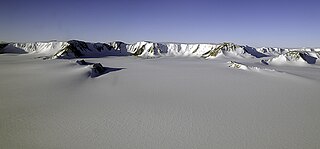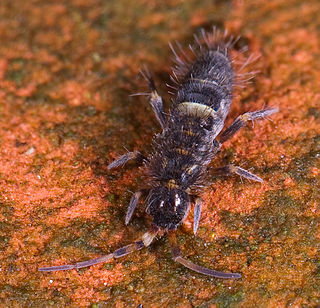
The Ross Ice Shelf is the largest ice shelf of Antarctica. It is several hundred metres thick. The nearly vertical ice front to the open sea is more than 600 kilometres (370 mi) long, and between 15 and 50 metres high above the water surface. Ninety percent of the floating ice, however, is below the water surface.

The Antarctic Peninsula, known as O'Higgins Land in Chile and Tierra de San Martín in Argentina, and originally as Graham Land in the United Kingdom and the Palmer Peninsula in the United States, is the northernmost part of mainland Antarctica.

The Shackleton Range is a mountain range in Antarctica that rises to 1,875 metres (6,152 ft) and extends in an east–west direction for about 100 miles (160 km) between the Slessor and Recovery Glaciers.

Thwaites Glacier is an unusually broad and vast Antarctic glacier located east of Mount Murphy, on the Walgreen Coast of Marie Byrd Land. It was initially sighted by polar researchers in 1940, mapped in 1959–1966 and officially named in 1967, after the late American glaciologist Fredrik T. Thwaites. The glacier flows into Pine Island Bay, part of the Amundsen Sea, at surface speeds which exceed 2 kilometres (1.2 mi) per year near its grounding line. Its fastest-flowing grounded ice is centered between 50 and 100 kilometres east of Mount Murphy. Like many other parts of the cryosphere, it has been adversely affected by climate change, and provides one of the more notable examples of the retreat of glaciers since 1850.

Ericiolacerta is an extinct genus of small therocephalian therapsids from the early Triassic of South Africa and Antarctica. Ericiolacerta, meaning "hedgehog lizard", was named by D.M.S. Watson in 1931. The species E. parva is known from the holotype specimen which consists of a nearly complete skeleton found in the Lystrosaurus Assemblage Zone within the Katberg Formation of the Beaufort Group in South Africa, and from a partial jaw found in the Lower Triassic Fremouw Formation in Antarctica. Ericiolacerta was around 20 centimetres (7.9 in) in length, with long limbs and relatively small teeth. It probably ate insects and other small invertebrates. The therocephalians – therapsids with mammal-like heads – were abundant in Permian times, but only a few made it into the Triassic. Ericiolacerta was one of those. It is possible that they gave rise to the cynodonts, the only therapsid group to survive into post-Triassic times. Cynodonts gave rise to mammals.

The geology of Antarctica covers the geological development of the continent through the Archean, Proterozoic and Phanerozoic eons.

Antarctica is Earth's southernmost and least-populated continent. Situated almost entirely south of the Antarctic Circle and surrounded by the Southern Ocean, it contains the geographic South Pole. Antarctica is the fifth-largest continent, being about 40% larger than Europe, and has an area of 14,200,000 km2 (5,500,000 sq mi). Most of Antarctica is covered by the Antarctic ice sheet, with an average thickness of 1.9 km (1.2 mi).

Springtails (Collembola) form the largest of the three lineages of modern hexapods that are no longer considered insects. Although the three orders are sometimes grouped together in a class called Entognatha because they have internal mouthparts, they do not appear to be any more closely related to one another than they are to all insects, which have external mouthparts.

Peter John Barrett is a New Zealand geologist who came to prominence after discovering the first tetrapod fossils in Antarctica in 1967.

The wildlife of Antarctica are extremophiles, having adapted to the dryness, low temperatures, and high exposure common in Antarctica. The extreme weather of the interior contrasts to the relatively mild conditions on the Antarctic Peninsula and the subantarctic islands, which have warmer temperatures and more liquid water. Much of the ocean around the mainland is covered by sea ice. The oceans themselves are a more stable environment for life, both in the water column and on the seabed.

Lake Washburn is a lake that formerly existed in the Taylor Valley, McMurdo Dry Valleys, Antarctica. It formed when climatic changes and an expansion of ice caused the flooding of the valley, between 23,000 and 8,340 radiocarbon years ago. Its extent and elevation are unclear but Lake Bonney and Lake Fryxell are considered to be its present-day remnant.
John Tenison Salmon was a New Zealand photographer, entomologist, academic, conservationist, and author. His primary occupation was as an entomologist; first at the Dominion Museum and then at Victoria University College.

Keith Arthur John Wise, often referred to as K. A. J. Wise, was a New Zealand entomologist. Originally employed at the Department of Scientific and Industrial Research, Wise began working with the Bishop Museum in the early 1960s, coordinating field programmes for United States visits to Antarctica and Subantarctic islands. This work led Wise to identify and describe large numbers of novel species, including many species of springtail. In 1965, Wise became the first Curator of Entomology at the Auckland War Memorial Museum, where he was integral in creating the first entomology section within the natural history gallery.

Acanthomurus rivalis is a species of springtail belonging to the family Isotomidae. The species was first described by Keith Arthur John Wise in 1964. The species is native to Campbell Island in the New Zealand Subantarctic Islands.

Cryptopygus campbellensis is a species of springtail belonging to the family Isotomidae. The species was first described by Keith Arthur John Wise in 1964. The species is native to Campbell Island in the New Zealand Subantarctic Islands.

Friesea litoralis is a species of springtail belonging to the family Neanuridae. The species was first described by Keith Arthur John Wise in 1964. The species is native to Campbell Island in the New Zealand Subantarctic Islands.

Parakatianna salmoni is a species of springtail belonging to the family Katiannidae. The species was first described by Keith Arthur John Wise in 1964. The species is native to Campbell Island in the New Zealand Subantarctic Islands.
Cryptopygus cisantarcticus is a species of springtail belonging to the family Isotomidae. The species was first described by Keith Arthur John Wise in 1967. The species is native to the Cape Hallett area of Northern Victoria Land in East Antarctica and the surrounding offshore islands, including the Balleny Islands.
Cryptopygus terranovus is a species of springtail belonging to the family Isotomidae. The species was first described by Keith Arthur John Wise in 1967, and is found on Antarctica.
Pseudosorensia atlantica is a species of springtail belonging to the family Isotomidae. The species was first described by Keith Arthur John Wise in 1970, and is found in South Georgia.















